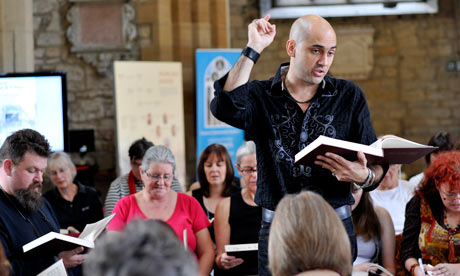What happens next is extraordinary. The leader chops out a downbeat, and the singers erupt into a full-throated roar that sounds more like the noise that greets a goal being scored than anything normally heard in church. Yet this is not a devotional service, but rather a "singing", in which enthusiasts come together to celebrate the music preserved in a volume of psalms, anthems and hymn tunes first published in Georgia in 1844 and known as the Sacred Harp.
If the sound of the Sacred Harp is strange, its appearance is even stranger. The tunes are arranged in four-part harmony, but instead of the familiar dots of musical notation the pitches are indicated by a series of triangles, diamonds and ovals in a simplified form of notation known as shape-note. The harmonies produced are raw and archaic, the pace unrelenting and the dynamic range fixed between loud and louder still. The devil doesn't stand a chance.
Shape-note singing is America's most ancient form of choral music. It reached its apotheosis in the years before the civil war, after which its influence began to decline as the smoother, more sophisticated sounds of gospel began to take over. But shape-note is enjoying a remarkable resurgence. In the 1950s, folklorists and song collectors such as Alan Lomax preserved the sound of old-time church singing, along with other disappearing forms of American music. But it unexpectedly reached a mass audience when Anthony Minghella used it for the soundtrack to his 2003 civil war film, Cold Mountain.
Since then, shape-note singing seems to be everywhere. MIA sampled Sacred Harp singers on her most recent album, and the haunting effect can be heard in the harmonic arrangements of folk-inspired acts such as Fleet Foxes and Arcade Fire. Its influence on American music is immeasurable. Johnny Cash and the Carter Family first learned to harmonise using the shape-note system – if you tune to any commercial country radio station, the tight harmonies will have their roots in some tiny Southern church.
The singing in Gateshead is led by Massachusetts-based multi-instrumentalist and musicologist Tim Eriksen, "a semi-reformed punk turned shape-note singer", who, as the founder of the folk-grunge band Cordelia's Dad, is almost certainly the only person to have shared a stage with both Kurt Cobain and country-folk legend Doc Watson. Eriksen established the world's largest Sacred Harp convention in Massachusetts; and was sought out by Minghella to perform on the Cold Mountain soundtrack and to coach Jude Law and Nicole Kidman in the style.
Eriksen's solo recordings have featured everything from Balkan flutes to symphony orchestras; though his latest album, Soul of the January Hills, is a collection of 14 traditional songs sung unaccompanied in a single take.
"I threw that out as a bit of a gauntlet," he says. "The unaccompanied human voice – which Southerners still refer to as the sacred harp – is the oldest instrument in the world, yet solo singing really only has a place now in lullabies, or in the shower."
He doesn't expect the album to sell in vast quantities: he points out that shape-note is a stubbornly un-commercial form of music. "People assume that Cold Mountain must have done for shape-note what O Brother, Where Art Thou? did for bluegrass. But really there's no comparison because, once you've paid $20 for a copy of the Sacred Harp, there's nothing else to sell. You can't pay to see a shape-note concert. But everyone's welcome to come along and sing themselves."
To prove the point, I'm handed a copy of the Sacred Harp and invited to find a place in the square. Each side is divided into treble, alto, tenor and bass, though men and women freely mix between sections, singing an octave apart. Eriksen takes his place in the centre and calls a tune, many of which are known not by title but the places they originated from. The tune listed in the Sacred Harp as New Britain, for instance, is better known as Amazing Grace. "You've got everything in here," Eriksen says, "Lutheran hymns, Scots jigs, Irish reels, field hollers, a smattering of Handel and Haydn: it all went into the meat grinder."
Even for a complete beginner, the shapes are remarkably easy to follow, as there are only four of them, placed higher or lower on the stave depending on their pitch. In the Sacred Harp these are known as soh, fah, la and mi. "This is strictly pre-Julie Andews," Eriksen says. "You don't even need doh, re and ti. These are pioneer songs sung by frontiersmen who didn't have much time to learn to read words, let alone music."
Eriksen makes a charismatic leader, whose coaching often makes use of rural analogies. "Keeping time couldn't be simpler," he says. "Just think of sheep jumping over a fence – just make sure you come down on the right side of the bar."
Though the open-throated harmonies violate every rule of classical counterpoint, there's an anarchic spirit and an invigorating sense of energy about shape-note singing that has enabled Eriksen successfully to introduce the style into social housing projects and punk clubs.
"Shape-note was America's first cult-music craze," he says. "Young kids still get it, even though we've been singing the same tunes for over 150 years. But I don't find that strange: after all, you eat dinner with the same people every day. You hang out with the same group of friends. The Sacred Harp is like family. In one sense, it's as familiar to me as my own skin, yet I still learn new things about it every day."
Soul of the January Hills by Tim Eriksen is out now on Appleseed Recordings. For a calendar of shape-note events in the UK, visit ukshapenote.org.uk
Two comments were received by the Guardian following pub;ication of this article. As usual, several details were misunderstood by the reporter; but at least there was cover in the national press!

01 October 2010 11:51 AMLink to this comment